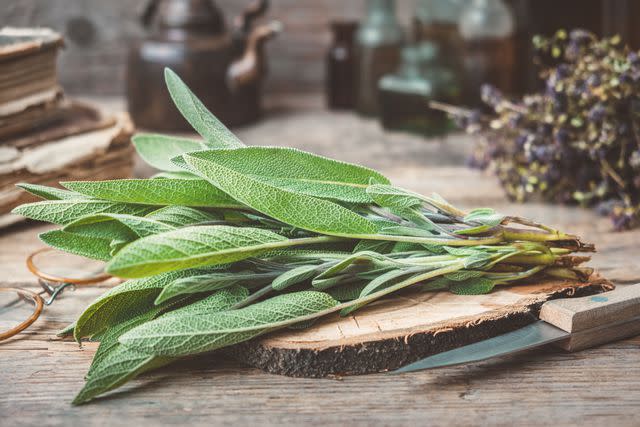How and When to Harvest Sage for Cooking and More
Fact checked by Marcus Reeves
Sage is one of the woody perennial herbs where a little goes a long way. Plants are rich in strong essential oils of camphor, thujone, and pineole which give this herb a musky, but sharp, pungent taste and aroma. Sage is a common ingredient in cooking, and is often tied in bundles for smudging or to be used as incense.
Whether you use it to season your holiday turkey or to make your home smell nice, learn how to harvest sage the right way.
When to Harvest Sage
Most leafy herbs retain richest flavor and aroma before flowering. Common garden sage can be an exception depending on your particular growing conditions. This means you can potentially harvest before, during, and after flowering, although leaf production will slow considerably once the stems set flowerbuds.
Growing conditions also play a role in bloom time. Common sage is hardy and may be evergreen or semi-evergreen to zone 4. It most often blooms in spring with two-lipped flowers in shades of purple appearing in whorls along the stem. Plants sometimes produce flowers throughout the growing season and even rebloom. Blooms last for several weeks with those on the lower stem drying up as flowers higher up continue to open. Try experimenting by harvesting leaves at different times and comparing flavor and quality to learn if flowering changes the taste of your sage leaves.
In the first year of growth, harvest lightly taking only a few leaves throughout the season. Once the plant has overwintered, developed a strong root system, and bushy growth, leaves can be harvested in greater quantities.
The best time of day to harvest is mid-morning after dew has dried and concentrated essential oils in the leaves.
Tip
Sage flowers are also edible and different varieties add flavors ranging from fruity to spicy. Flowers are used in teas, and made into jellies, vinegars, and syrups among other culinary applications.

ChamilleWhite / Getty Images
How to Harvest Sage
Throughout the growing season, harvest sage by the leaf or by removing a stem with a whorl of leaves. In late winter or very early spring, cut back your plants by about one-third of the total growth, to just above a node. Depending on winter conditions in your growing zone, fresh leaves may remain on the plant and are fine to use, but may have some diminished flavor. A small hand pruner or clipper works well for late winter pruning. Otherwise using your thumb and forefinger to pinch leaves works best for harvesting sage.
Look for leaves between one and five inches long, solidly green without spots or insect damage.
Use your thumb and forefinger to pinch off the leaf with its stem where it joins the main stem.
Or, pinch the main stem below the top whorl of leaves. Pinch the stem back to the second top most whorl of leave.
In late winter, around the end of February, use a small hand pruner or clipper to cut your sage plant back by up to one-third. Remove and discard any discolored or damaged leaves and use or dry any viable leaves from the cuttings.
How to Dry and Store Sage
Sage leaves are thick compared to many other leafy green herbs and take some time to dry naturally.
Do this by taking cuttings with four to five inches of stem attached. Bind two or three stems together with a rubber band or twine and hang them upside down in a dry location, out of direct sunlight with good air circulation. The denser your bundle, the longer it takes leaves to dry with greater potential for mold to develop.
Lay individual leaves flat on a paper towel-covered tray for natural drying. Single leaves dry more quickly than bundled stems.
You can dry sage in a food dehydrator or low-temperature oven. The best drying temperature is between 95 and 115°F.
Place fresh whole leaves in plastic bags or layered in freezer containers, remove air, and freeze for up to a year.
The leaves are dry when they crumble easily. However, storing them in whole-leaf form preserves the flavor. As soon as leaves are broken down they begin to lose essential oils, so dry them whole and rub them between your palms or use an herb grinder to add them to food.
The leaves must be completely dry before storage to avoid mold and discoloration. Glass containers with tight-fitting lids retain the best flavor and color for the longest time. If you choose to grind the herb before storage it should be used within a year.
To store fresh sage, wrap leaves in a paper towel and place them in the refrigerator. Or remove lower leaves and place stems in a small amount of water. Use fresh sage within a week.
Tips for Harvesting Sage
Harvest lightly the first year. Once the plant is well established you can harvest more leaves.
Harvest the leaf with its stem. Stems can be removed before storing.
Harvest only the green, new growth stems and avoid cutting into woody portions of the stems during the growing season.
Look for leaves between one and five inches in length, blemish free, with solid green/gray color.
Leaves can be harvested throughout the growing season but it's better for the plant to take larger harvests prior to flowering.
Cut sage plants back by one-third in late winter to promote bushier growth during the next season.
Read Next: How to Harvest Lavender
Read the original article on The Spruce.

